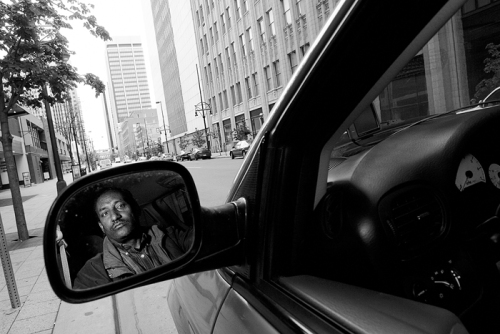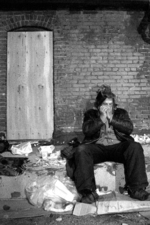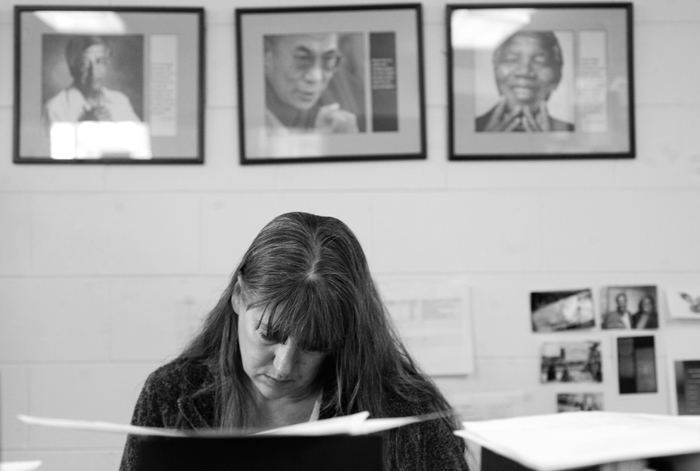Published February 2009 Vol. 13 Issue 1
by William Hillyard
illustration by Kenn Penn
photographs by Preston Drake-Hillyard
Patti Church eased her car around the corner and into the swirling crowd, stopping near the piles of clothing spilling from ripped plastic trash bags. Flimsy folding tables stood waiting for her. As Patti opened her car door, she became the center of the crowd; volunteers looked to her for direction, asking questions—where do you want this, who is to do that? One man, his face bristling with a silver stubble, opened Patti’s trunk and began unloading paper grocery bags to the folding tables, others grabbed cases of soda, boxes of cakes, plastic trays of salads, until the wobbly tables were top-heavy with food. Another, Francisco, grabbed a box from the car’s back seat, then stood shuffling from foot to foot, looking for an opening to the tables. As Patti approached, about fifty men, their weathered hands warmed in worn pockets, congealed into a tight group.
Rafael paced around the rear of the crowd, his sun-browned face taut with worry. He could see Patti, there behind the tables, her arms pointing, gesturing, her blond bob framing her soft face. The hiss of the nearby highway overpass drowned her words. Rafael hadn’t made it back to his camp the night before, and when he returned in the morning he found that it had burned; southern California winter had arrived after a long, warm autumn, bringing an icy rain and night-time temperatures near freezing. The others, retreating from the cold and the rain, had built their fire too close to the shelter. It caught fire and burned everything. Rafael returned to find that he possessed, literally, only the clothes on his back. He needed Patti’s help. A man, his arms stretched around a polyester comforter, wiggled in behind Rafael and over his shoulder shouted, “Who’s the one who lost his camp last night?” Rafael looked around with a start. “Who’s the one who lost his camp?” Other men gestured at Rafael. “You the one?” Rafael nodded as the man pushed the bundle into his arms, his fingers barely clasping around it. Patti had come through again.
“These men live simply,” Patti says of them, “They send most of what they earn home to their families in Mexico.” In the past, she fed about 50 men here each night, but the number has swollen recently to 60 or more. The men she and her group feed here on this corner spend their days along busy, nearby Doheny Park Road standing facing traffic, waiting for work. This street has been a day labor site for two decades and has seen anti-immigration protests in recent years by groups like the Minutemen. In fact, a group of Minutemen held a “flag rally” here in January, their first demonstration of 2009. “Nothing has taken place,” said one Minuteman, videotaping his group’s protest. “Our purpose, so far, has been successful; there have been zero hires. No body is picking up the illegal aliens,” he continued into his camera. They came to disrupt the hiring of day laborers, but the economy had already done their job for them.
It is not that day laborers like Rafael choose to live outdoors; it’s just that, as the U.S. economy slows, the work doesn’t come. The current day labor trend has grown up around the boom in construction and the collapse in the industry has affected day laborers disproportionately. California alone has lost more than 200,000 construction jobs since the peak two years ago according to the U.S. Bureau of Labor Statistics. Construction work in Southern California, like elsewhere in the country, has all but disappeared.












